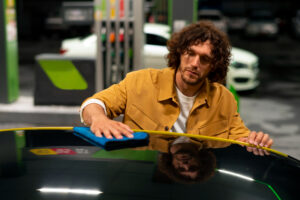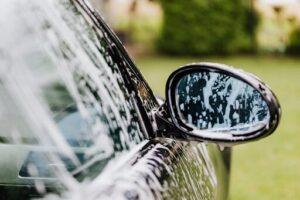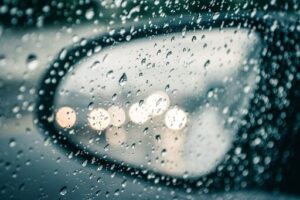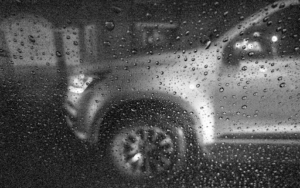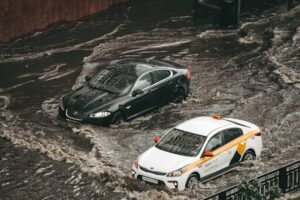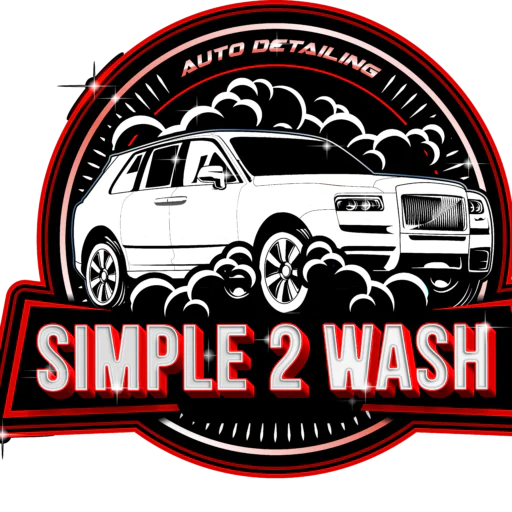Have you ever washed your car and let it shine in the sun, only to notice your reflection in the paint? Yes, it feels wonderful. Having a brand-new car makes you stand out, boosts your confidence, and makes every drive a little more exciting. Maintaining that flawless, glossy sheen is more challenging than it may seem. Even seemingly harmless bird droppings, flying stones, unpredictable weather, and repeated driving can cause significant paint damage. Paint protection film (PPF) might be useful. However, there is one crucial issue you must address before visiting the closest installer: how long does it take to PPF a car?
What Is PPF Anyway?
Let’s define PPF first before getting into time. Paint Protection Film is a clear, incredibly resilient polyurethane coating that is applied directly over the paint of your vehicle. Consider it your vehicle’s invisible armor.
It shields your car from:
- Rock chips on the highway
- Harsh UV rays
- Scratches from careless handling
- Annoying bird droppings or tree sap
Some enthusiasts call it “sunscreen for your car,” but it’s tougher than that. Modern PPF is self-healing, which means light scratches can vanish when the film is warmed up, either by the sun or a heat gun. It’s like magic—only backed by science.
No wonder car lovers and daily drivers alike are investing in it. PPF offers more than just visual protection for expensive or distinctive vehicles, such as the Tesla Cybertruck. It keeps the panels clean, stops corrosion on the finish, and increases their resale value. In summary, it’s a wise investment as well as a luxury.
How much time does it take to get a car PPF?
The rapid answer is that it might take one to five days, depending on complexity and coverage. But let’s analyze it.
- Full vs. Partial Coverage
- Depending on its size, a luxury SUV like a Mercedes G-Class or Range Rover takes three to four days.
- A Cybertruck or other angular vehicle will require three to five days because of its special stainless-steel panels.
Expect more time if your car has intricate trims, curves, or sharp lines. Installers are meticulous; they don’t hurry. The goal is defeated by a badly applied PPF that has bubbles or raised edges. The film should appear to be a natural part of the paint rather than an afterthought.
Examples
- It usually takes one to two days to fully cover a Toyota Corolla or Honda Civic.
- Depending on its size, a luxury SUV like a Mercedes G-Class or Range Rover takes three to four days.
- A Cybertruck or other angular vehicle will require three to five days because to its special stainless-steel panels.
A few days may seem like a long wait, but accuracy, security, and comfort all depend on this.
What Takes Place During the Procedure?
Here’s an overview of what goes on behind the scenes at a professional PPF business instead of dull charts:
Step 1: Completely Clean and Get Ready
When applying any film, the surface of your car must be spotless. Installers thoroughly wash your automobile before applying a clay bar treatment to remove any trapped dirt or industrial debris. Some even rub the paint lightly to smooth it out.
Depending on how old or unclean the paint is, it takes two to five hours.
Ignoring this step? Don’t pay attention to it. When trapped dirt creates bubbles beneath the coating, it creates a waiting emergency.
Step 2: Cutting the Film
Next, the film is cut to match your car’s exact dimensions. Most pros use computer-cut software for precision. For modified or uniquely shaped vehicles, installers may cut by hand. It’s slower, yes, but ensures a perfect fit.
Step 3: The Main Event—Application
This is where the magic happens:
- The installer sprays a slip solution on the surface.
- The film is carefully placed and aligned.
- Every bubble is pushed out using squeegees, with extra attention to edges and curves.
This stage alone can take 8 to 20 hours, depending on coverage. Being exact is crucial because rushing it could result in creases, air pockets, and elevated edges.
Step 4: Reviewing and Curing
The film requires time to cure after application. For the adhesive to completely adhere, that is often overnight, but occasionally longer. The installer examines every inch, presses down the edges, and cleans it when it has cured.
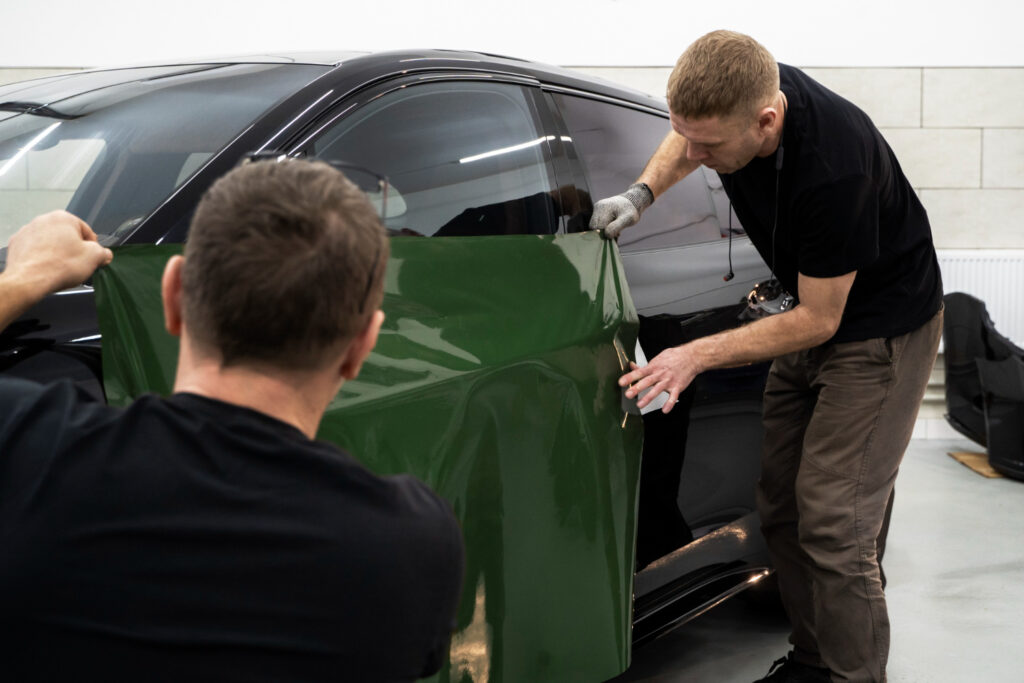
Factors Influencing Installation Duration
Some installations take longer than others. Here’s why:
- Car Size and Shape
Bigger cars = more panels = more time. A small sedan may take a day or two; a large SUV or Cybertruck can take 5 days. - Coverage Level
Partial wraps are faster than full-body wraps. Think of it as trimming a small area versus shaving the whole car. - Paint Condition
The paint must be corrected first if it has oxidation, swirl marks, or scratches. Imperfections trapped under the film are impossible to fix later. - Installer Skill and Tools
Experienced shops with high-end tools and software cut time down without compromising quality. Hand-cutting is slower but often more precise. - Weather Conditions
Glue curing is influenced by temperature and humidity. Conditions that are moist or cold can prolong the process by one day.
The Cybertruck “Rust” Debate
Let’s clear the air about Cybertrucks and rust.
The Myth
Some think stainless steel means “never rusts.”
The Reality
Those orange spots? Usually surface contamination—iron particles from brakes, dust, or road debris oxidizing. The steel itself remains unharmed.
The Fix
Regular cleaning plus PPF solves this. The film prevents contaminants from sticking, preserving the futuristic look and keeping maintenance minimal.
How Long Does It Take to PPF a Cybertruck or Similar Vehicles?
Despite its flat panels, the Cybertruck’s sharp edges make installation tricky. Installers must:
- Align edges precisely
- Avoid visible smudges
- Work carefully around complex angles
Time estimate: 3–5 days for full-body coverage. Yes, patience is key here.
Is It Worth the Wait?
Absolutely. A few days without your car is nothing compared to years of protection.
Benefits include:
- Scratch and chip protection from road debris
- UV and stain protection
- Improved resale value
- Peace of mind on long drives
Waiting for quality results isn’t just reasonable—it’s smart.
Aftercare: Don’t Rush the Cure
After installation, the film needs time to bond:
- Avoid washing for 48–72 hours
- Small bubbles or haze? Normal—they disappear within a week
- Avoid high-pressure washes or harsh sunlight during curing
Once settled, you can treat your car like normal.
Tips to Maximize Your PPF
- Choose quality film: Brands like XPEL, 3M, and SunTek last 7–10 years.
- Go pro: DIY may seem tempting, but mistakes are costly.
- Wash gently: Use pH-neutral soaps and soft cloths.
- Avoid automatic washes: Stick to hand washing to protect edges.
- Consider ceramic coating: Adds gloss, repels dirt, and makes cleaning easier.
Final Thoughts
Getting your automobile PPF’d offers useful protection in addition to being a matter of taste. This thin, translucent covering protects your vehicle from years of wear and tear, regardless of whether you drive a tough Cybertruck or a little sedan. Although installing it takes a few days, it is nothing in comparison to decades of paint preservation, less scratches, and higher resale value. Your best friends are expert hands, high-quality materials, and patience.
Frequently Asked Questions
1. Can I drive my car immediately after applying PPF?
Not immediately. Proper bonding between the paint and the film takes time. It is recommended to wait 24 to 48 hours before driving regularly. In colder or more humid environments, waiting a bit longer ensures that the glue sets properly and avoids potential lifting or bubbling.
2. What is the duration of PPF?
Depending on maintenance and exposure to the environment, high-quality PPF films often last seven to ten years. High-end companies like SunTek, 3M, and XPEL even provide warranties against peeling or yellowing. The lifespan of the film can be increased with proper maintenance, such as mild washing and avoiding harsh chemicals.
3. Will PPF prevent my automobile from rusting?
Indirectly, indeed. PPF shields your paint against environmental contaminants including salt, grime, and broken metal. The main causes of corrosion are often these contaminants. While it won’t completely stop rust, it greatly reduces the chance of surface damage.
4. Does installing PPF on a Cybertruck or other stainless steel vehicle make sense?
Naturally. Despite its resistance to corrosion, stainless steel can have smudges, stains, and surface oxidation. PPF protects your future car from dings and scratches and prevents contaminants from sticking. It is practically required for expensive or well-known automobiles.
5. Can ceramic coating be applied on top of PPF?
Yes! In fact, many professional installers suggest putting a ceramic coating once the film has dried. This increases shine, strengthens the hydrophobic properties, and facilitates cleaning. Before applying any coatings, ensure that the PPF has fully bonded for best effects.


